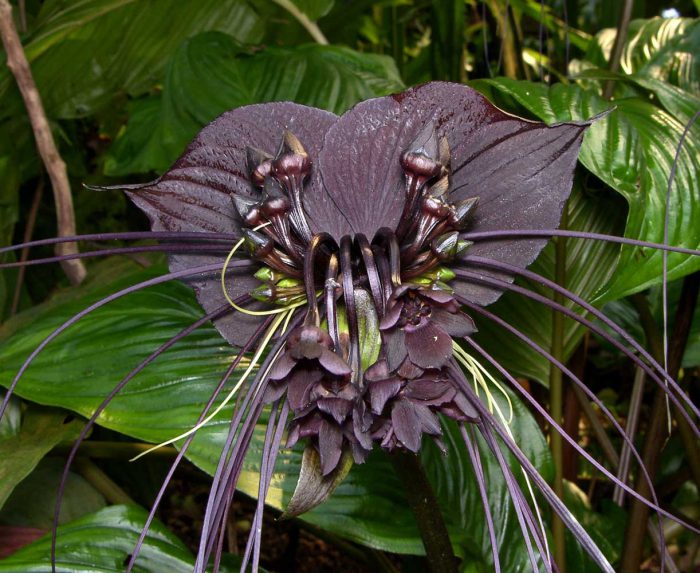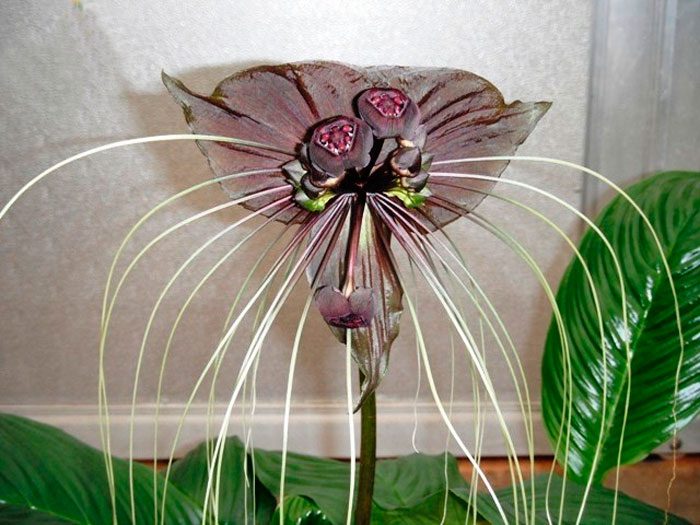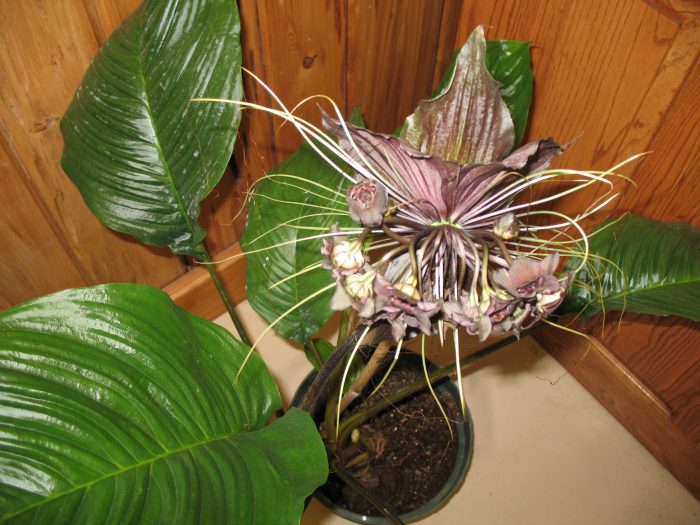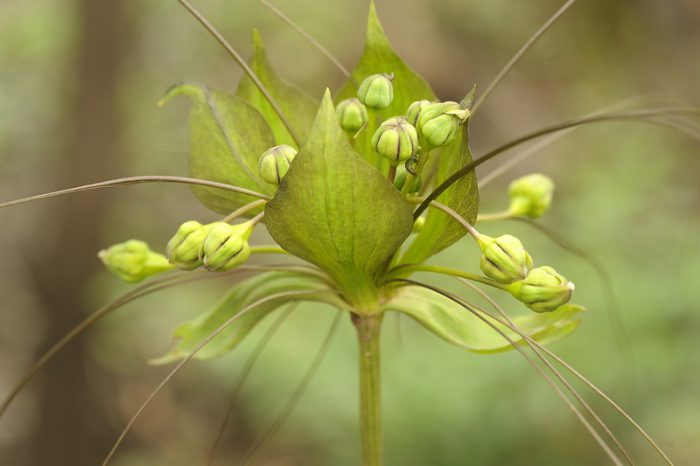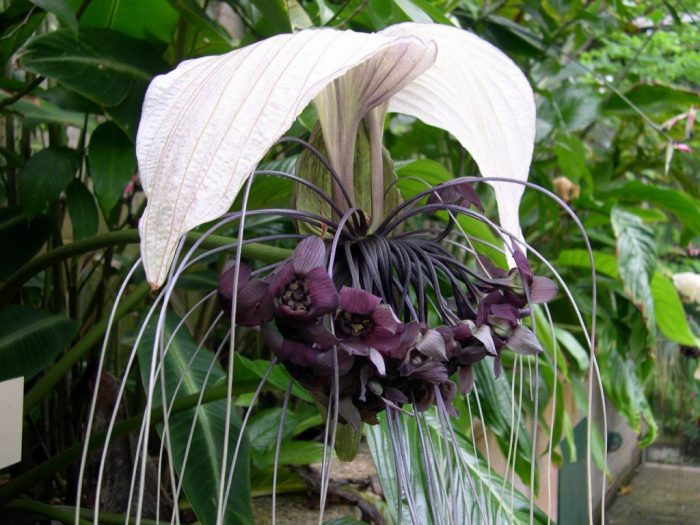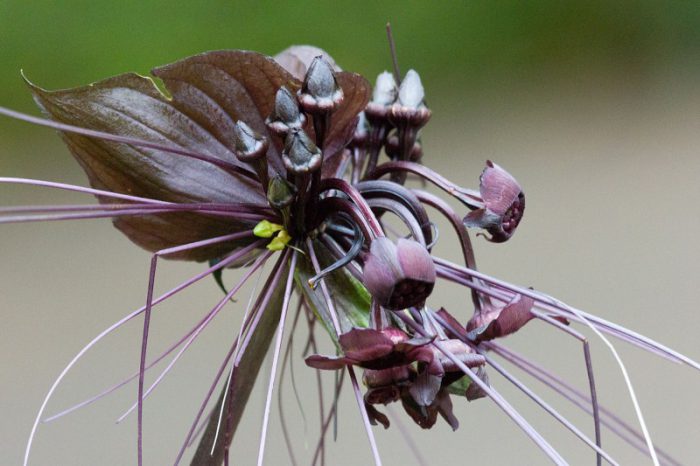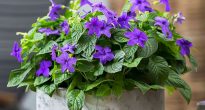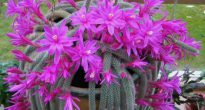A perennial herb like takka (Tassa) occurs naturally in the western regions of Africa and in Southeast Asia. For the growth and normal development of this plant, no specific conditions are required. It can grow both in open sunny places and in shaded places (for example: forests, savannas, thickets). Such a flower is found both on the sea coast and on the mountain slope.
In takka, creeping rhizomes are represented by a tuberous developmental system. Glossy rather large leaves are located on long petioles with a ribbed surface. This plant is quite large and, depending on the species, it can reach 40–100 centimeters in height. There are plants of this genus that grow up to 300 centimeters in height. There is pubescence on the surface of young shoots, but it gradually disappears as the flower matures.
This plant stands out among the rest with its unusual flowers, which have an unusual color and structure. Arrows rise above the foliage, at the ends of which there are umbrella-shaped inflorescences, consisting of 6-10 flowers. Some species have elongated bracts. After flowering, the takka produces fruits presented in the form of berries. In the plantain tacca, the fruit is presented in the form of a box. Such a flower has many seeds for propagation.
Takka care at home
Illumination
This plant grows well in shaded areas. It should be protected from direct sunlight. Recommended to be placed on an East or West orientation.
Temperature regime
Due to the fact that this plant is tropical, it needs to provide an appropriate temperature regime. In summer, the temperature in the room should be between 18 and 30 degrees. From the beginning of the autumn period, the temperature should be gradually reduced to 20 degrees and try to maintain it at this level throughout the winter and spring. The room where the takka is located should not be colder than 18 degrees. Fresh air has a beneficial effect on this plant, but when airing the room, do not forget to protect it from the effects of drafts.
Humidity
The flower requires high humidity, and it should be borne in mind that it reacts extremely negatively to dry air.The plant should be regularly humidified from a sprayer, and household humidifiers should be installed in the room. The pot should be placed on a wide pallet, into which expanded clay or moss should first be poured and a little water should be added. It is also recommended to regularly arrange "steam baths" at night. To do this, the flower is left in a room filled with steam overnight.
How to water
Water should be abundant on hot summer days. It is recommended to do this immediately after the top layer of the substrate dries out a little. With the onset of the autumn period, watering should be reduced to moderate. In winter, it is necessary to water the flower only after the substrate dries out to a third of the height of the container. Make sure that there is no overdrying or waterlogging of the soil. It is recommended to water the takka with soft, well-settled water, which should not be cold.
Earth mix
Suitable soil for planting should be loose and breathable very well. You can also use a commercial potting mix designed for orchids for planting. You can make a suitable soil mixture with your own hands, for this it is necessary to combine sod and leafy soil, as well as sand and peat, which should be taken in a ratio of 1: 2: 1: 2.
Top dressing
Top dressing should be carried out from the beginning of spring to mid-autumn. Fertilizers should be applied to the soil regularly 2 times a month. Takka cannot be fertilized in winter. For top dressing, it is recommended to use ordinary flower fertilizers, but you should take ½ part of the dose recommended on the package.
Transplant features
Transplanting such a plant is carried out only if absolutely necessary. It is recommended to carry out such a procedure in the spring, when the roots are completely stronger after wintering. A new pot should be taken slightly larger than the previous one. Otherwise, the probability of flooding the plant is high. Before planting, a drainage layer must be made at the bottom of the pot.
Reproduction methods
This plant is propagated, as a rule, by seeds, as well as by dividing the rhizome.
Before proceeding to the division of the rhizome, it is necessary to carefully cut off the part of the plant that rises above the soil surface. Then you need to divide the rhizome into several parts, using a very sharp knife for this. Places of cuts should be treated with crushed charcoal, and then leave the cut for 24 in the open air to dry. Planting pots should be chosen that will match the size of the division, and they should be filled with light soil.
Before proceeding with the direct sowing, you need to prepare the seeds. Seeds should be placed in warm water (about 50 degrees) and left there for a day. For sowing, a loose substrate is used, and the seeds are buried by 1 centimeter. In order to maintain high humidity, the container must be covered with foil or glass on top. In order for seedlings to appear faster, it is necessary to maintain the temperature of the substrate at a level of at least 30 degrees. As a rule, seedlings appear after 1-9 months from the date of sowing.
Diseases and pests
Most often settles on the plant spider mite... If such a pest is found, it is recommended to treat the takka with an acaricidal agent. If you water the flower too abundantly, rot may appear on it.
Video review
Main types
Tacca leontopetaloides
This is the tallest type of takkov known. This plant can reach a height of 300 centimeters. It has pinnately cut, very large leaves that can be up to 60 centimeters wide, and they also have a decent length - about 70 centimeters. Violet-green flowers are hidden under a pair of large pale green bedspreads.Long, pointed bracts can be up to 60 centimeters long. After the end of flowering, fruits are formed in the form of berries.
Tacca whole-leafed or White bat (Tacca integrifolia)
The homeland of this evergreen plant is India. This type differs from the others in its rather wide leaves with a mirror-smooth surface. They can be up to 35 centimeters wide and 70 centimeters long. The flowers are covered with a pair of white fairly large twenty-centimeter bedspreads. The flowers themselves can be painted in dark purple, black or purple. The bracts of this plant are very thin, cord-like and can reach 60 centimeters in length. The fruits are formed, presented in the form of berries.
Tacca Chantrieri or Black Bat (Tacca chantrieri)
This tropical evergreen plant is closely related to the whole-leaf tucka. However, they have obvious external differences. In height, such a flower can reach 90-120 centimeters. Long-petiolate wide leaves are folded at the base. On such a plant, up to 20 flowers, painted in a glossy brownish-red color, can appear. Moreover, they are bordered by bracts of a maroon color, which are similar to the wings of a bat or butterfly.

